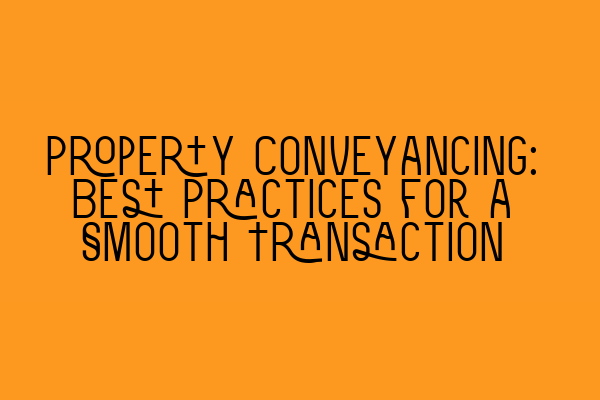Property Conveyancing: Best Practices for a Smooth Transaction
As a leading solicitor at SQE Property Law & Land Law, I understand the importance of a smooth property conveyancing transaction. Whether you are buying or selling a property, it is essential to have a thorough understanding of the process to avoid any potential pitfalls. In this blog post, I will provide you with some best practices to help ensure a seamless and stress-free property conveyancing experience.
1. Seek Professional Advice:
One of the first steps in property conveyancing is to engage the services of a solicitor who specializes in property law. Their expertise and knowledge will guide you through the entire conveyancing process, ensuring that all necessary legal requirements are met. If you’re not sure where to start, SQE Property Law & Land Law offers expert advice and assistance in all property-related matters.
2. Conduct Thorough Due Diligence:
Before entering into any property transaction, it is crucial to conduct thorough due diligence. This process involves investigating the property’s title, reviewing any existing planning permissions or restrictions, and checking for any potential legal issues. It is always recommended to engage the services of a professional surveyor to identify any hidden defects or structural issues with the property.
3. Obtain a Comprehensive Property Report:
Obtaining a comprehensive property report is essential to understanding the property’s history and any potential risks associated with it. This report will provide details about the property’s ownership, any potential disputes, planning or environmental concerns, and any ongoing maintenance and service charges. By having a clear understanding of the property’s history, you can make informed decisions and avoid any surprises down the line.
4. Ensure Proper Documentation:
One of the most crucial aspects of property conveyancing is ensuring that all necessary documentation is in order. This includes the contract of sale, title deeds, and any relevant planning permissions or consents. Your solicitor will guide you through the process of reviewing and preparing these documents to ensure that they accurately reflect your intentions and protect your interests.
5. Arrange Proper Financing:
If you require financing to purchase the property, it is important to arrange this well in advance. Speak to your bank or mortgage broker to ensure that you have a pre-approved mortgage in place and understand the terms and conditions associated with it. This will help avoid any delays in the conveyancing process and provide you with a clear understanding of your financial obligations.
6. Consider Potential Stamp Duty Liabilities:
Stamp duty is a tax imposed on property transactions, and it is essential to consider any applicable liabilities. Your solicitor will advise you on the current stamp duty rates and inform you of any exemptions or reliefs that may be applicable to your situation. By understanding your stamp duty obligations upfront, you can budget accordingly and avoid any unexpected financial burdens.
7. Communicate Effectively:
Effective communication is key throughout the conveyancing process. Ensure that you maintain regular contact with your solicitor, estate agent, and any other relevant parties. This will help keep everyone informed and ensure that any issues or concerns are addressed promptly. Regular communication will also provide you with peace of mind, knowing that progress is being made towards a successful completion.
8. Be Proactive:
Being proactive in the conveyancing process can help avoid potential delays or complications. Respond promptly to any requests for information or documentation from your solicitor, lender, or any other parties involved. By being proactive, you can ensure that the conveyancing process moves forward smoothly and efficiently.
9. Prepare for Completion:
As the completion date approaches, ensure that you have everything in order for a smooth transition. This includes arranging for the transfer of utilities, notifying relevant authorities of your change of address, and organizing any removal services. By preparing in advance, you can reduce the stress associated with moving into your new property.
10. Review the Final Documentation:
Before finalizing the transaction, carefully review all the documentation provided by your solicitor. This includes the contract of sale, transfer deeds, and any additional agreements or warranties. If you have any questions or concerns, do not hesitate to seek clarification from your solicitor. It is important to ensure that everything is in order before proceeding with the completion.
In conclusion, navigating property conveyancing can be a complex and daunting process. However, by following these best practices and seeking professional advice from a solicitor specializing in property law, you can ensure a smooth and successful transaction.
For more information on property conveyancing and related legal topics, check out these articles:
– Understanding Contractual Capacity: Rights and Limitations
– Interactive SQE Mock Tests for Contract Law: Test Your Knowledge
– Join Our SQE Contract Law Webinars: Expert Insights and Guidance
– Contract Law Reforms: An Analysis of Recent Changes
– Parties in a Contract: Rights and Responsibilities
At SQE Property Law & Land Law, we are committed to providing expert guidance and support throughout the property conveyancing process. Contact us today to speak with one of our experienced solicitors and ensure a smooth and stress-free property transaction.
